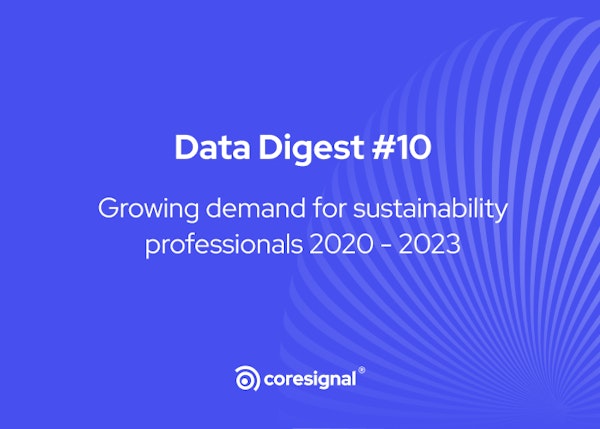Professional network data
Leverage our top B2B datasets
Job posting data
Get access to hundreds of millions of jobs
Employee review data
Get data for employee sentiment analysis
Clean dataNEW
Enhanced professional network data
Employee data
Get data on global talent at scale
Funding data
Discover and analyze funding deals
Firmographic data
Unlock a 360° view of millions of companies
Technographic data
Analyze companies’ tech stacks
BY INDUSTRY
MOST POPULAR USE CASES
Investment
Leveraging web data for informed investing
HR tech
Building or enhancing data-driven HR tech
Sales
Supercharging your lead generation engine
Marketing
Transforming marketing with web data
Market research
Conducting comprehensive market research
Lead enrichment
Use Coresignal’s data for enrichment
Talent analytics
Analyze talent from multiple perspectives
Talent sourcing
Comprehensive talent data for recruitment
Investment analysis
Source deals, evaluate risk and much more
Target market analysis
Build a complete view of the market
Competitive analysis
Identify and analyze competitors
B2B Intent data
Lesser-known ways to find intent signals
BY INDUSTRY
MOST POPULAR USE CASES
Investment
Leveraging web data for informed investing
HR tech
Building or enhancing data-driven HR tech
Sales
Supercharging your lead generation engine
Marketing
Transforming marketing with web data
Market research
Conducting comprehensive market research


Coresignal
March 1, 2023
Startups are exciting ventures that have all the potential in the world for both failure and success. Venture capital firms and investors always look for promising early-stage companies to support financially for future profit.
Startups in the Series A funding round are often the most attractive. On the one hand, such a startup is not completely new, having an at least partly proven business model that got them through the seed round. On the other hand, the potential return on investment (ROI) is higher here than in the later startup funding rounds like Series B, Series C, or Series D.
Thus, let’s look at different funding stages focusing on Series A funding. This guide will help to find Series A startups and determine whether they are worth considering for investment.
What are Series A startups?
Let’s begin with a quick overview of the different funding rounds to see how Series A funding stands out.
Pre-seed funding
Pre-seed funding is where it all starts. At this earliest stage, the startup founder or founders only have the basic idea and raise the initial funds. The funding at the pre-seed stage comes from the founder’s own capital, family, friends, and angel investors rather than hedge funds and other institutional investors.
Seed funding
The seed funding stage is where venture capitalists come in. Additionally, seed funding can use the same sources of investment as pre-seed funding from a friend to an angel investor. At this stage, the startup aims to raise enough money to turn an idea into a company and get it going.
Series A funding
After the early stages of seed funding comes Series A funding. This is where seed-funded companies are expected to show a strategy and a promising business model.
If the company has not attracted enough traction until the seed capital runs out, it will never get to raise Series A, Series B, or later startup funding stages. Thus, companies in the series A funding stage are the survivors attracting more potential investors.
Investors at this stage come from traditional venture capital firms. Usually, one anchor investor leads the pack. Securing the first investor is crucial as after that, other investors will often join soon enough.
Previous investors that have joined in the seed round might also continue investing at this point. However, the role of angel investors is now smaller than that of venture capital financing. Startups are expected to increase revenue at this stage.
Series B funding
Series B funding is all about expansion. The company has already proven at an earlier stage that its product or service has a market. Now it needs more money to enlarge its resources and grow its customer base. Series B and Series C funding rounds are where private equity firms and large hedge funds show up after letting venture capitalists take risks associated with early-stage companies.
Series C funding
The companies that get to the Series C funding round are doing very well and have grown significantly after the Series B funding. Now it is ready to buy other companies or expand to new markets. Additionally, Series C funding often prepares the company for its Initial Public Offering (IPO).
The investors in the series C funding round are usually private equity firms and investment bankers. Often series C funding is the final push for the company, and only a few go on to raise Series D or even Series E rounds.
Series D and E funding
Series D funding round happens rarely and for two kinds of reasons. It might be that the company has decided to stay private a little longer after the Series C funding to expand and explore new markets. Or Series D becomes necessary if the expected marks have not been hit and the company needs more money raised to get back on track.
The same goes for the Series E funding round which comes if even Series D funding proved not enough. As mentioned, companies rarely get to these stages, as Series B or Series C funding rounds are usually followed by an IPO.

How to evaluate a Series A startup for investment
The company’s growth level in the Series A stage is perfect for many venture capital firms. The funds raised at this stage are usually between $2 and $15 million.
Funding Series B and especially Series C companies is much more complicated due to the involvement of private equity funding and other large players. Additionally, in the Series B funding round and beyond, there are expected to be fewer investors but larger sums invested.
The main objective is then choosing the right series A startup to invest in and evaluating it correctly. This can be tricky when it comes to early-stage startups as they have not yet been long enough to make traditional data analysis reliable.
Series B, Series C, and later-stage startups can be evaluated through financial analysis as they have already produced tangible metrics, such as revenue or growth rate. With Series A companies, investors must turn to market research and creative projection of startups' potential.
Here are three examples of commonly used methods for evaluating an early-stage startup.
The Venture Capital (VC) method
Harvard business school professor Bill Sahlman developed the venture capital method in 1987. The VC method involves multiplying the startup's projected revenue by its projected margin and industry price-to-earnings to determine its valuation. To this day, this method is often preferred by venture capital firms.
The Scorecard method
Meanwhile, angel investors tend to prefer the scorecard method, developed by one of their own - Bill Payne. There are multiple steps to the scorecard method of startup evaluation. Its essence, however, comes down to evaluating seven key factors, giving them the following relative weights.
- Strength of the management team (0-30%)
- Opportunity size (0-25%)
- Product and technology (0-15%)
- Competition (0-10%)
- Marketing, distribution channels, partnerships (0-10%)
- Need for additional investment (0-5%)
- Other (0-5%)
As one can see, a strong team and leadership position is considered the most important factor when evaluating a Series A startup. It is also worth noting that the quality of the product and technology of the startup is more important than the competition it faces.
Risk factor summation method
This method considers 12 risk factors of investing in a startup, which range from those associated with the management and stage of the company to political and international risks. The startup is scored based on its capacity to mitigate these risks to determine its valuation.
The Berkus method, developed by Dave Berkus can be seen as a middle ground between risk factor summation and scoreboard methods. It also evaluates such features of the startup as the basic idea or the management team but conceptualizes them as risk mitigation factors.
Best practices for finding new series A startups
Below are some methods and resources to consider when looking for new series A startups for investment opportunities.
Networking
The classical method of finding investment opportunities is going out there and networking. There are multiple networking events organized constantly, which provide a good opportunity to meet other investors and startup founders. Joining an angel investors network that meets regularly to discuss investment opportunities is a great way to find series A startups while learning and sharing with other investors.
Online deal-sourcing platforms
Online deal-sourcing has the advantage of efficiently finding the best startups that are looking for equity funding. Under this approach, VC firms and investors would use online match-finding or crowdfunding platforms to identify promising startup companies.
Tracking successful founders
As we can see from the startup valuation methods above, experienced investors value a strong team more than anything else. Thus, startup founders' data is a great resource for recognizing the best early-stage equity funding opportunities. Such data can reveal the startup with an experienced person in the leadership position and inform on their previous success.
Tracking technological stack
Another highly-valued feature is the new technology that the startup uses or offers as its product. That this no wonder considering that the best startups are often associated with boosting exciting next-generation solutions.
Thus, looking at technographic data on new firms will help to identify the best Series A startups. Additionally, this information has a wider potential for startup growth as it approaches the Series B funding round. Beneficial partnerships can be formed with other firms that produce compatible new technology.
Don’t miss a thing
Subscribe to our monthly newsletter to receive product-related news and use cases, exclusive offers, and expert data content
By providing your email address you agree to receive newsletters from Coresignal. For more information about your data processing, please take a look at our Privacy Policy.

Utilizing machine learning and automation
Finding the best equity funding opportunities requires sifting through a lot of data due to the fast dynamics of startup creation and growth. To do it efficiently, investors use machine learning algorithms and automation tools that are best for dealing with large volumes of hard data.
The limitation of this method is that even the best next-generation AI is not as good as humans at evaluating high-uncertainty factors such as how innovative the product truly is. Thus, scientists are proposing hybrid methods of using machine learning for past data analysis and human intelligence for interpreting “soft” signals in determining the potential of a Series A startup.

Series A Startups Statistics
Here are some facts and statistics worth knowing when analyzing Series A Startups for investment opportunities.
The failure rates of early-stage companies are lower than thought
The often-cited “fact” that 8 out of 10 startups fail before reaching the Series A funding round is incorrect. Although it is commonly held that most startups fail within the first 18 months, there is no conclusive evidence to support it. In fact, studies and statistics show that about half of the new companies in the USA reach 5 years in business.
The further you go, the easier it gets
Evidence from European startup research suggests that companies reaching Series A, Series B, and later funding rounds have an increasingly rising chance of success. This is depicted by the progressively flattening curve of the failure rate as companies progress through funding stages.
As noted by Statista, the rapid decline between seed funding and Series A funding rounds does not necessarily indicate failure, companies might become self-sustaining or choose to exit.
Revenue can come early
According to the veteran investor Peter Wagner, his firm’s research shows that up to 67% of companies in the series A funding round are already generating revenue. This number has grown steadily over the last decade.
Seasons become less important
It is commonly held that fundraising for startups is seasonal, with down periods during the summer followed by a surge later in the year. However, a study of last year’s US software market’s Series A funding, conducted by venture capitalist Tomasz Tunguz, suggests that currently, the decline of fundraising deals might be progressive rather than seasonal.
The value rises
As mentioned, the Series A round funds might be as low as $2 million. Usually, however, they are larger. In the USA, the mean Series A funding round is currently valued at $10-$15 million. This figure has been growing steadily.

Overview of the Series A funding round
The Series A funding stage is a lot like the other equity funding rounds. The founders give the investors a stake in the company affairs in exchange for the funds to carry on. This round, however, stands out as the turning point for many startups.
Firstly, this is the round where more investors come in, potentially expecting a say in the company. Thus, founders with the best ideas also pick their best fit, often as carefully as investors pick their opportunities.
Secondly, the companies in the Series A round are usually in it for growth. They have not exited yet, and if they can raise Series A funds, their success probability starts rising. Thus, this is where venture capital firms need to get in since the Series B round competition might be too strong.
Furthermore, the Series A funding round is where the basic idea has to be substantiated. It might be the revenue that the startup generates, or it might just be traction and a well-developed business model. But investors at this point will want to see a clear and comprehensible strategy for success.
Finally, since investors that invest at this stage will usually reinvest in the Series B round and later to ensure that their share does not decrease with new investors coming in, the decision made here has long-term consequences.
All this makes the Series A funding round crucial for both founders and investors. The former need to raise enough money to win a stable place in the market. While the latter has the best shot at choosing the right fit from the many startups out there.
Related articles

Sales & Marketing
10 Most Reliable B2C and B2B Lead Generation Databases
Not all lead databases are created equal. Some are better than others, and knowing how to pick the right one is key. A superior...
Mindaugas Jancis
April 23, 2024

Sales & Marketing
It’s a (Data) Match! Data Matching as a Business Value
With the amount of business data growing, more and more options to categorize it appear, resulting in many datasets....
Mindaugas Jancis
April 9, 2024

Data Analysis
Growing demand for sustainability professionals 2020–2023
Original research about the changes in demand for sustainability specialists throughout 2020–2023....
Coresignal
March 29, 2024